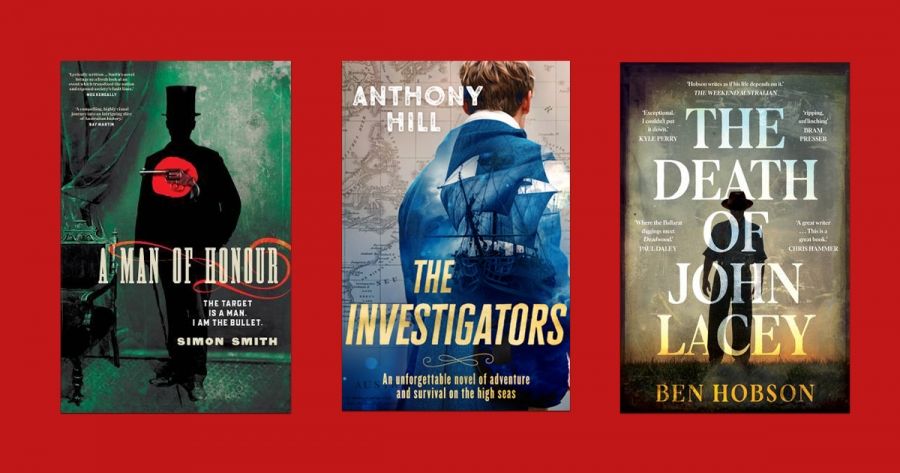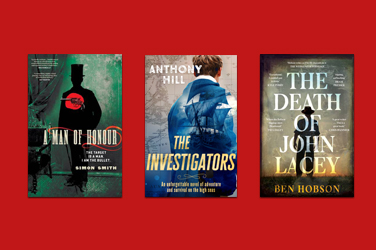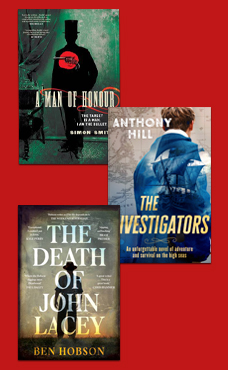
- Free Article: No
- Contents Category: Fiction
- Custom Article Title: Three new novels about historical masculinity
- Review Article: Yes
- Article Title: 'Such sadism, such pain'
- Article Subtitle: Three novels about historical masculinity
- Online Only: No
- Custom Highlight Text:
In recent historical fiction, women authors have explored the Australian past from a female viewpoint, as in Kate Grenville’s A Room Made of Leaves (2020), focusing on Elizabeth Macarthur, and Anita Heiss’s Bila Yarrudhanggalangdhuray, River of Dreams (2022), about Wagadhaany, an Indigenous woman from the Murrumbidgee River. As if in response to such potent novels, now comes a trio expressing historical masculinity.
- Featured Image (400px * 250px):

- Alt Tag (Featured Image): Stephen Knight reviews three new novels on historical masculinity
- Book 1 Title: A Man of Honour
- Book 1 Biblio: Echo Publishing, $32.99 pb, 337 pp
- Book 1 Cover Small (400 x 600):

- Book 1 Cover (800 x 1200):

- Book 2 Title: The Death of John Lacey
- Book 2 Biblio: Allen & Unwin, $32.99 pb, 342 pp
- Book 2 Cover Small (400 x 600):

- Book 2 Cover (800 x 1200):

- Book 3 Title: The Investigators
- Book 3 Biblio: Michael Joseph, $32.99 pb, 349 pp
- Book 3 Cover Small (400 x 600):

- Book 3 Cover (800 x 1200):

O’Farrell’s family, of Irish origin, were ‘charity’ immigrants from Britain to Australia. His mother pressed early Celtic myths on him as a child, and when he later visited Ireland he saw ‘such sadism, such pain’ that his anti-English radicalism was confirmed. Disturbed by the execution of the three Irish ‘Manchester Martyrs’ late in 1867, he attended a meeting of Sydney Fenians, who agreed that one would shoot the soon-to-arrive prince. Though he voted against the idea, O’Farrell drew the bleak lottery result – though later, presenting himself in prison as of deeply troubled mind, and so not executable, he denied that this happened.
In court, his sister speaks strongly for him as essentially insane, but the jury disagrees: here, O’Farrell himself says that Aspinall, the courtroom grandee who had in 1854 successfully defended the men of Eureka, was both too ‘ripe’ and too ‘florid’. Equally dubious is Parkes, whose interest in O’Farrell seems based on developing his own fame. The author uses as epigraph to the novel two verses by Parkes (also a prolific poet) that find a ‘gentle face’ and ‘beauty free from pride or blame’ on one who lived ‘but to terrorize’. Yet as a final note to the book, Smith reports that these lines were in fact written in 1885 about Sofia Perevskaia, a Russian woman terrorist. The very frame of this strong narrative raises doubt about public assertions – like believing that Simon Smith’s distant relative was sane enough to be executed.
Ben Hobson is the author of two successful novels with nature settings, To Become a Whale (2017) and Snake Island (2019). In The Death of John Lacey (Allen & Unwin, $32.99 pb, 342 pp), he offers a robust story about nineteenth-century human experiences. Lacey is a greedy bully who prospers in early gold-mining days and has a town named after him. The rather confused young Ernst Montague and his Indigenous half-brother Joe encounter Lacey’s violent malice, and resist him seriously, in ways that should be left for readers to discover.
The novel has powerful scenes, such as Ernst’s mother dying in a fire, and before that his ex-convict father enjoying himself with his other woman, the Indigenous mother of Joe. The author also seems to know film techniques: he cuts boldly from one character and period to another, and finally introduces as commentator Father Gilbert Delaney, gentle but ill, who observes the Montague-Lacey drama’s grand final scene. Hobson explores convincingly the difficulties of seeking for gold, and the response of the Indigenous locals in a novel that effectively combines past credibility and sudden drama.
The third book is another historical account, with strong archival details. In The Investigators (Michael Joseph, $32.99 pb, 349 pp), Anthony Hill simply adds novelistic colour to detailed material that deals with Matthew Flinders’ famous first exploratory charting voyage around Australia in 1801, adding as a viewpoint his shipmate John Franklin, a fifteen-year-old midshipman who had already witnessed Nelson’s first distinction at the Battle of Copenhagen.
Flinders finds the great continent at its south-west point and sails near the coast all the way to Port Jackson, facing maritime storms and reefs – and other dangers. Nine men will be dead of dysentery by the end of this journey. Of the ten in a small boat that capsizes, only two can swim: eight drown or are eaten by sharks at what Flinders calls Cape Catastrophe. He leads, and charts, strongly throughout, but is constantly thinking of his new wife, Ann, whom the admiralty did not permit to sail with him, as he had planned. Meanwhile, young Franklin learns about navigation and charting and steadily develops his nautical trade, despite having difficulties with Flinders’ younger brother Samuel.
After reaching Port Jackson they soon sail on, with the ship slowly rotting. The rest of the circuit of Australia is made more quickly: Indigenous man Bungaree helps with the natives they meet. When they finally leave Sydney for home, now in a better ship, they are suddenly stranded on what Flinders naturally names Wreck Reef. He heads back in a cutter for a new boat: the others bravely sleep on the sand and, with their many skills, build a new schooner from the wreckage. Soon Franklin and others sail all the way home in one ship, but Flinders travels separately on another, which also proves unsafe. He has to put into French-run Mauritius, where the brutal governor imprisons him for six years. He arrives home, quite ill, in 1810. After writing his famous account of A Voyage to Terra Australis, he dies in 1814. Franklin continues sailing, including to Trafalgar, and before long on three Arctic voyages: the last in 1847 ends when all the men, including Vice-Admiral Sir John Franklin, are trapped in the ice and lost.
The Flinders journey has been recounted before, by Ernestine Hill in My Love Must Wait (1941): that was rather more novel-like, with Ann Flinders appearing at the beginning and the conclusion. Anthony Hill himself humanises credibly the data he has researched, and in what he says will be his final novel adds a convincing reality narrative to this trio of men-in-history stories. Perhaps their narrow masculinity might inspire a new modern response: Kate Grenville’s account of Mrs Ann Flinders, waiting as she did for nine years for her once new husband, would itself be worth a wait.



Comments powered by CComment